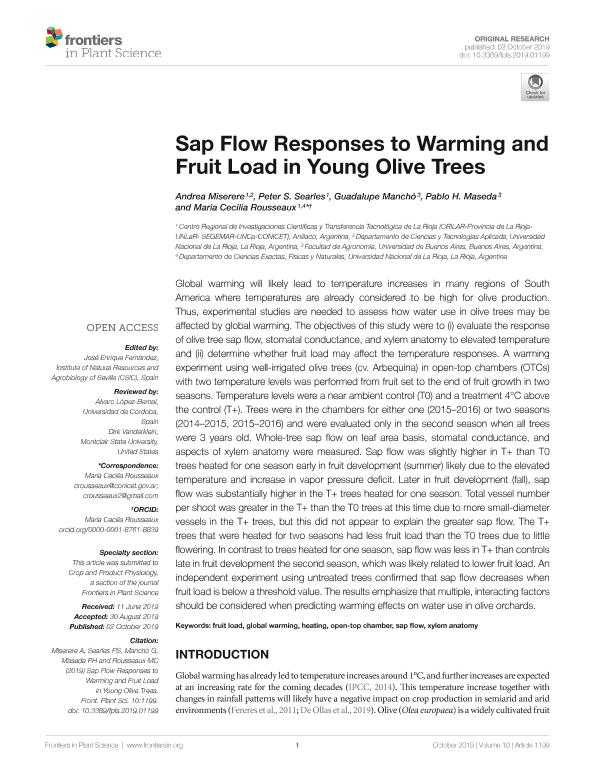Mostrar el registro sencillo del ítem
dc.contributor.author
Miserere, Andrea

dc.contributor.author
Searles, Peter Stoughton

dc.contributor.author
Manchó, Guadalupe

dc.contributor.author
Maseda, Pablo H.
dc.contributor.author
Rousseaux, Maria Cecilia

dc.date.available
2021-03-09T21:22:49Z
dc.date.issued
2019-10-02
dc.identifier.citation
Miserere, Andrea; Searles, Peter Stoughton; Manchó, Guadalupe; Maseda, Pablo H.; Rousseaux, Maria Cecilia; Sap Flow Responses to Warming and Fruit Load in Young Olive Trees; Frontiers Media S.A.; Frontiers in Plant Science; 10; 1199; 2-10-2019; 1-13
dc.identifier.issn
1664-462X
dc.identifier.uri
http://hdl.handle.net/11336/127870
dc.description.abstract
Global warming will likely lead to temperature increases in many regions of South America where temperatures are already considered to be high for olive production. Thus, experimental studies are needed to assess how water use in olive trees may be affected by global warming. The objectives of this study were to (i) evaluate the response of olive tree sap flow, stomatal conductance, and xylem anatomy to elevated temperature and (ii) determine whether fruit load may affect the temperature responses. A warming experiment using well-irrigated olive trees (cv. Arbequina) in open-top chambers (OTCs) with two temperature levels was performed from fruit set to the end of fruit growth in two seasons. Temperature levels were a near ambient control (T0) and a treatment 4°C above the control (T+). Trees were in the chambers for either one (2015–2016) or two seasons (2014–2015, 2015–2016) and were evaluated only in the second season when all trees were 3 years old. Whole-tree sap flow on leaf area basis, stomatal conductance, and aspects of xylem anatomy were measured. Sap flow was slightly higher in T+ than T0 trees heated for one season early in fruit development (summer) likely due to the elevated temperature and increase in vapor pressure deficit. Later in fruit development (fall), sap flow was substantially higher in the T+ trees heated for one season. Total vessel number per shoot was greater in the T+ than the T0 trees at this time due to more small-diameter vessels in the T+ trees, but this did not appear to explain the greater sap flow. The T+ trees that were heated for two seasons had less fruit load than the T0 trees due to little flowering. In contrast to trees heated for one season, sap flow was less in T+ than controls late in fruit development the second season, which was likely related to lower fruit load. An independent experiment using untreated trees confirmed that sap flow decreases when fruit load is below a threshold value. The results emphasize that multiple, interacting factors should be considered when predicting warming effects on water use in olive orchards.
dc.format
application/pdf
dc.language.iso
eng
dc.publisher
Frontiers Media S.A.

dc.rights
info:eu-repo/semantics/openAccess
dc.rights.uri
https://creativecommons.org/licenses/by-nc-sa/2.5/ar/
dc.subject
FRUIT LOAD
dc.subject
GLOBAL WARMING
dc.subject
HEATING
dc.subject
OPEN TOP CHAMBER
dc.subject
SAP FLOW
dc.subject
XYLEM ANATOMY
dc.subject.classification
Horticultura, Viticultura

dc.subject.classification
Agricultura, Silvicultura y Pesca

dc.subject.classification
CIENCIAS AGRÍCOLAS

dc.title
Sap Flow Responses to Warming and Fruit Load in Young Olive Trees
dc.type
info:eu-repo/semantics/article
dc.type
info:ar-repo/semantics/artículo
dc.type
info:eu-repo/semantics/publishedVersion
dc.date.updated
2020-11-13T20:44:32Z
dc.journal.volume
10
dc.journal.number
1199
dc.journal.pagination
1-13
dc.journal.pais
Suiza

dc.journal.ciudad
Lausanne
dc.description.fil
Fil: Miserere, Andrea. Universidad Nacional de La Rioja; Argentina. Consejo Nacional de Investigaciones Científicas y Técnicas. Centro Regional de Investigaciones Científicas y Transferencia Tecnológica de La Rioja. - Universidad Nacional de La Rioja. Centro Regional de Investigaciones Científicas y Transferencia Tecnológica de La Rioja. - Universidad Nacional de Catamarca. Centro Regional de Investigaciones Científicas y Transferencia Tecnológica de La Rioja. - Secretaría de Industria y Minería. Servicio Geológico Minero Argentino. Centro Regional de Investigaciones Científicas y Transferencia Tecnológica de La Rioja. - Provincia de La Rioja. Centro Regional de Investigaciones Científicas y Transferencia Tecnológica de La Rioja; Argentina
dc.description.fil
Fil: Searles, Peter Stoughton. Consejo Nacional de Investigaciones Científicas y Técnicas. Centro Regional de Investigaciones Científicas y Transferencia Tecnológica de La Rioja. - Universidad Nacional de La Rioja. Centro Regional de Investigaciones Científicas y Transferencia Tecnológica de La Rioja. - Universidad Nacional de Catamarca. Centro Regional de Investigaciones Científicas y Transferencia Tecnológica de La Rioja. - Secretaría de Industria y Minería. Servicio Geológico Minero Argentino. Centro Regional de Investigaciones Científicas y Transferencia Tecnológica de La Rioja. - Provincia de La Rioja. Centro Regional de Investigaciones Científicas y Transferencia Tecnológica de La Rioja; Argentina
dc.description.fil
Fil: Manchó, Guadalupe. Universidad de Buenos Aires. Facultad de Agronomía; Argentina
dc.description.fil
Fil: Maseda, Pablo H.. Universidad de Buenos Aires. Facultad de Agronomía; Argentina
dc.description.fil
Fil: Rousseaux, Maria Cecilia. Consejo Nacional de Investigaciones Científicas y Técnicas. Centro Regional de Investigaciones Científicas y Transferencia Tecnológica de La Rioja. - Universidad Nacional de La Rioja. Centro Regional de Investigaciones Científicas y Transferencia Tecnológica de La Rioja. - Universidad Nacional de Catamarca. Centro Regional de Investigaciones Científicas y Transferencia Tecnológica de La Rioja. - Secretaría de Industria y Minería. Servicio Geológico Minero Argentino. Centro Regional de Investigaciones Científicas y Transferencia Tecnológica de La Rioja. - Provincia de La Rioja. Centro Regional de Investigaciones Científicas y Transferencia Tecnológica de La Rioja; Argentina
dc.journal.title
Frontiers in Plant Science
dc.relation.alternativeid
info:eu-repo/semantics/altIdentifier/url/https://www.frontiersin.org/article/10.3389/fpls.2019.01199/full
dc.relation.alternativeid
info:eu-repo/semantics/altIdentifier/doi/https://doi.org/10.3389/fpls.2019.01199
Archivos asociados
